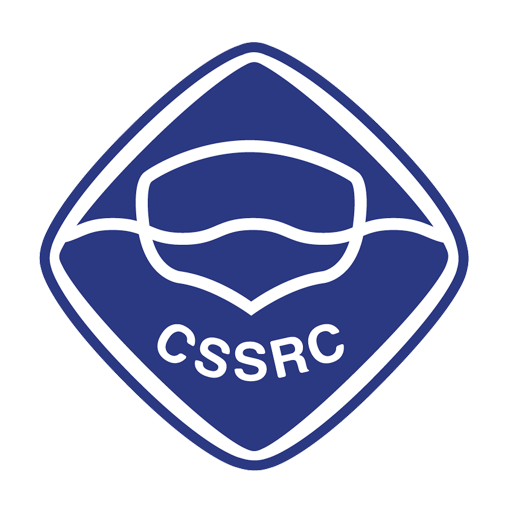CONTENTS OF JOURNAL OF HYDRODYNAMICS Vol.34 No.5 2022
CONTENTS
REVIEW ARTICLE
Chi Zhang, Yu-jie Zhu, Dong Wu, Nikolaus A. Adams, Xiangyu Hu(767)
ARTICLES
Christopher J. Keylock(806)
Wen-jie Zhong, Wen-tao Wang, De-cheng Wan(826)
Xiang-hao Zheng, Yu-ning Zhang(849)
Hui Wang, Ren-chuan Zhu, Meng-xiao Gu, Le Zha(864)
Wen-wen Zhang, Rong-wu Xu, Lin He, Jia Duan(876)
Ting-yun Yin, Giorgio Pavesi, Ji Pei, Shou-qi Yuan, Xing-cheng Gan(893)
Yvan Arosquipa Nina, Rui Shi, Davide Wüthrich, Hubert Chanson(904)
Mohammad Ahmadi, Alban Kuriqi, Hossein Mohammad Nezhad, Amir Ghaderi, Mirali Mohammadi(917)
Yi-tian Chen, Xiao-ling Wang, Song-min Li, Ya-zhi Zheng, Guang-yao Dong(934)
Xian-peng Yang, Can Cai, Xiao-hua Chen, Pei Zhang, Xin Zeng, Chi Peng, Yingfang Zhou(948)
LETTERS
Yifei Yu, Yi-qian Wang, Chaoqun Liu(965)
Qian Wang, Hao-cheng Lu, Chang-ze Zhao, Hua Liu(970)
Wen-yang Duan, Kun Zheng, Bin-bin Zhao(975)
旋成体湍流噪声的壁面模化大涡模拟
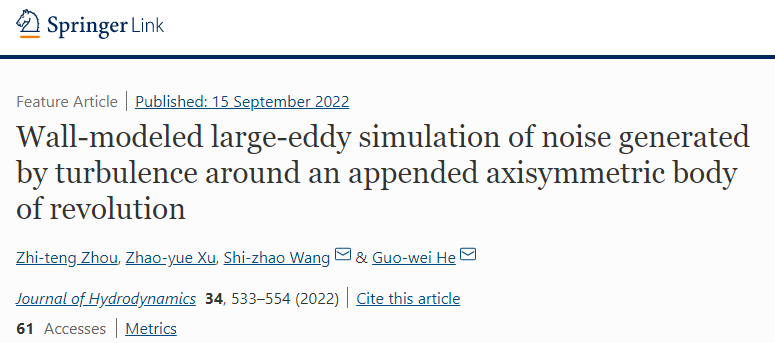 引用格式:Zhou, Z., Xu, Z., Wang, S. et al. Wall-modeled large-eddy simulation of noise generated by turbulence around an appended axisymmetric body of revolution. J Hydrodyn 34, 533–554 (2022).
引用格式:Zhou, Z., Xu, Z., Wang, S. et al. Wall-modeled large-eddy simulation of noise generated by turbulence around an appended axisymmetric body of revolution. J Hydrodyn 34, 533–554 (2022).
DOI:https://doi.org/10.1007/s42241-022-0062-z
Share this article:https://rdcu.be/cWufk
大涡模拟是新一代计算流体力学软件的核心工具,有望应用于工程湍流非定常特征和水动力噪声研究。但是,大涡模拟所需的网格量约正比于雷诺数的平方,是其用于复杂几何边界高雷诺数工程湍流的重要困难。壁面模化大涡模拟通过引入近壁流动模型避免完全解析近壁流动,是突破高雷诺数壁湍流大涡模拟困难的一种途径。现有的近壁流动模型主要用于槽道湍流等标准算例的研究,还很少应用到实际工程模型当中。本文借助非平衡型近壁流动模型,结合Ffowcs Williams与Hawkings声比拟理论,实现了全附体SUBOFF标模湍流噪声的壁面模化大涡模拟。
本文考查了壁面模化大涡模拟预测潜航器非定常涡结构、壁面压力系数、脉动压力等与流动和噪声密切相关量的能力,得到了正确的压力系数沿艇体分布规律和脉动压力的频谱特征,发现非平衡型模型能够反映艇体曲率变化以及附体对流场的影响;考查了艇体横截面的远场噪声偶极子指向性,发现该指向性区别于经典的圆柱绕流辐射噪声指向性。定量的分析表明,该指向性来自于侧向力与升力偶极子的相消干涉与相长干涉。本文的结果表明壁面模化大涡模拟可以预测流场中的非定常流动特征和远场噪声指向性的机理,是研究潜航器湍流脉动量和声场的可能途径。
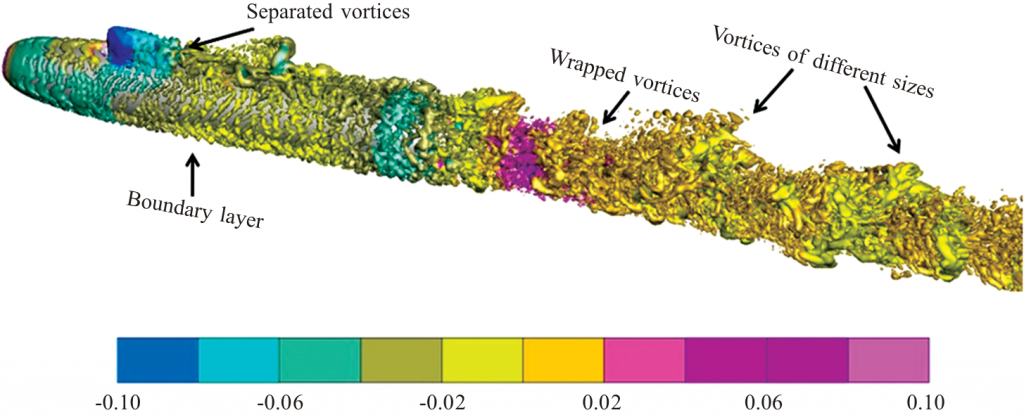 图1 潜航器附近的瞬时流场结构
图1 潜航器附近的瞬时流场结构
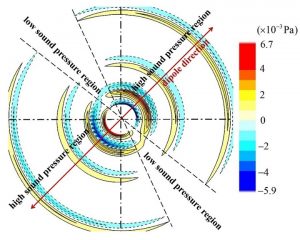 图2 艇体横截面的瞬时声场
图2 艇体横截面的瞬时声场
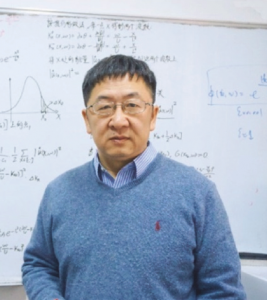 何国威,中国科学院力学研究所学术所长、学术委员会主任,中国科学院院士、研究员。长期从事湍流和计算流体力学的研究,提出的湍流时空关联的EA模型和大涡模拟的时空关联方法,被美国物理学会评价为对理解湍流的时空关联和发展时间精准的湍流模型做出了基本(fundamental)贡献。主要学术成果发表在《Annu. Rev. Fluid Mech.》,《J. Fluid Mech.》,《Phys. Rev. Fluids》,《J. Comput. Phys.》,《Phys. Rev. Lett.》等期刊上。曾获国家杰出青年科学基金,现任美国物理学会《Phys. Rev. Fluids》杂志副主编,中国力学学会《Acta Mech. Sin.》副主编,中国力学学会期刊《Theor. Appl. Mech. Lett.》主编。
何国威,中国科学院力学研究所学术所长、学术委员会主任,中国科学院院士、研究员。长期从事湍流和计算流体力学的研究,提出的湍流时空关联的EA模型和大涡模拟的时空关联方法,被美国物理学会评价为对理解湍流的时空关联和发展时间精准的湍流模型做出了基本(fundamental)贡献。主要学术成果发表在《Annu. Rev. Fluid Mech.》,《J. Fluid Mech.》,《Phys. Rev. Fluids》,《J. Comput. Phys.》,《Phys. Rev. Lett.》等期刊上。曾获国家杰出青年科学基金,现任美国物理学会《Phys. Rev. Fluids》杂志副主编,中国力学学会《Acta Mech. Sin.》副主编,中国力学学会期刊《Theor. Appl. Mech. Lett.》主编。
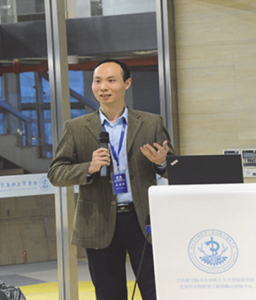
王士召,中国科学院力学研究所研究员。主要从事湍流与计算流体力学研究,相应工作发表于《J. Fluid Mech.》,《J. Comput. Phys.》,《AIAA J.》等流体力学重要期刊。主持国家自然科学基金委优秀青年科学基金项目、国家数值风洞工程基础研究重点课题等,任《Acta Mech. Sin.》和《力学进展》青年编委,中国力学学会湍流与流动稳定性专业组成员,中国工业与应用数学学会数学力学专业委员会委员,中国空气动力学会计算空气动力学委员会委员。
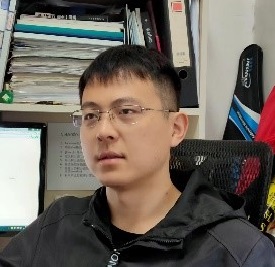 周志腾,中国科学院力学研究所在读博士研究生。周志腾于2018年进入中国科学院力学研究所攻读博士学位,从事湍流噪声领域相关的科研工作,曾针对四极子声源穿出FW-H积分面导致的虚假噪声问题,利用格林函数的渐近展开,提出了一种四极子噪声修正模型。该模型克服了传统模型在部分马赫数下计算结果发散的问题,并成功应用在钝体绕流的远场噪声计算当中。相关成果已发表于《AIAA J.》,《Theor. App. Mech. Lett.》等期刊。
周志腾,中国科学院力学研究所在读博士研究生。周志腾于2018年进入中国科学院力学研究所攻读博士学位,从事湍流噪声领域相关的科研工作,曾针对四极子声源穿出FW-H积分面导致的虚假噪声问题,利用格林函数的渐近展开,提出了一种四极子噪声修正模型。该模型克服了传统模型在部分马赫数下计算结果发散的问题,并成功应用在钝体绕流的远场噪声计算当中。相关成果已发表于《AIAA J.》,《Theor. App. Mech. Lett.》等期刊。
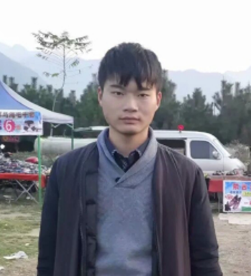
许昭越,中国科学院力学研究所在读博士研究生。2018年毕业于西北工业的航空学院后加入力学所非线性国家重点实验室攻读博士学位,从事计算流体力学相关研究。主要工作内容有:复杂边界的近壁速度重构、数据驱动量纲分析。已在《J. Comput. Phys.》,《Phys. Fluids》等流体力学期刊上发表学术论文5篇。担任《Phys. Fluids》,《Acta Mech. Sin.》期刊的审稿人。
水力损失与旋涡演化内在关联机制:以水泵水轮机泵工况为例
在水力机械的设计与研究中,提升水力效率、降低水力不稳定特性是永恒的目标。提升水力效率的本质在于降低流域内水力损失,而改善水力机械不稳定特性的本质在于控制水力损失在不同流量工况的分布规律。因此,水力损失特性宏观上决定了水力机械运行特性,微观上又与旋涡演化有着千丝万缕的关联。如何正确的表征水力损失,并探明水力损失与旋涡演化之间的关联是一个无法回避的问题。本期,我们推荐哈尔滨工业大学王洪杰教授、李德友教授团队近期在Journal of Hydrodynamics(第34卷第4期)发表的 “水力损失与旋涡演化内在关联机制:以水泵水轮机泵工况为例”的文章。
DOI:https://doi.org/10.1007/s42241-022-0053-0
Share this article:https://rdcu.be/cWRHU
水力损失方面,在初期的研究中,学者们习惯性采用流线所表现的流动特性来定性的描述水力损失,如:回流,二次流,涡团周期性演化等等。但该方法难以精确描述水力损失在流域中分布情况;近十年来,借用热力学概念的熵产损失方法及从N-S方程(Navier-Stokes equations)中所推导出的微分动能平衡方程方法被广泛应用于水力损失的定量描述中,但这两种方法与水力损失的等价性缺乏严格的理论验证。本文基于从N-S方程中推导出的微分动能平衡方程及Boussinesq假设,推导出湍流流动中水力损失成分,发现水力损失由流域内耗散作用及输运作用共同导致。传统熵产损失方法仅仅描述耗散作用而忽略输运作用,而输运作用恰恰是区分流域内水力损失和热力学损失的关键。
旋涡方面,流体机械水力特性源于关键流域内涡系的复杂时空演化。涡量定义为流体速度的旋度,是用于描述旋涡运动的重要物理量。本文为克服传统Cauchy-Stokes涡量分解方法的不足,采用美国德州大学阿灵顿分校刘超群教授提出的Liutex第三代涡识别技术,将涡量分解为刚性涡量及剪切涡量两部分。根据量纲分析,涡量不能作为旋涡演化的代表物理量与水力损失作比。因此在本研究中,选取表征旋涡结构强度的拟涡能及表征涡量输运过程中所涉及的能量的涡量输运强度作为旋涡演化的代表物理量。
利用数值模拟方法(Computational Fluid Dynamics,CFD),并借助数理统计中皮尔逊相关系数(Pearson correlation coefficient)对水泵水轮机泵工况关键流域内水力损失与旋涡演化之间的空间分布相关性进行探究。分析结果表明水力损失中耗散效应与变形涡量拟涡能相关性为非常强,而水力损失中输运效应与刚性涡量输运强度相关性为强。该结果不仅与刘超群教授涡量剪切占优结论具有良好一致性,更表明虽然刚性涡量占总涡量比例较小,但刚性涡量输运行为所导致的水力输运损失却不可忽略,该结论丰富了刚性涡的研究领域,为进一步研究水力损失与旋涡之间的关联建立良好基础;同时,本文所提出的水力损失概念不仅具有直观物理意义,更能反映微观旋涡演化特征,可作为今后研究水力损失的代表性物理量。
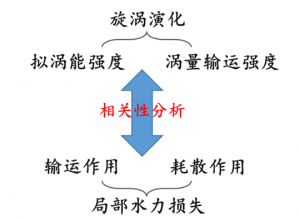 图1 水力损失-旋涡演化关性相关性分析流程
图1 水力损失-旋涡演化关性相关性分析流程
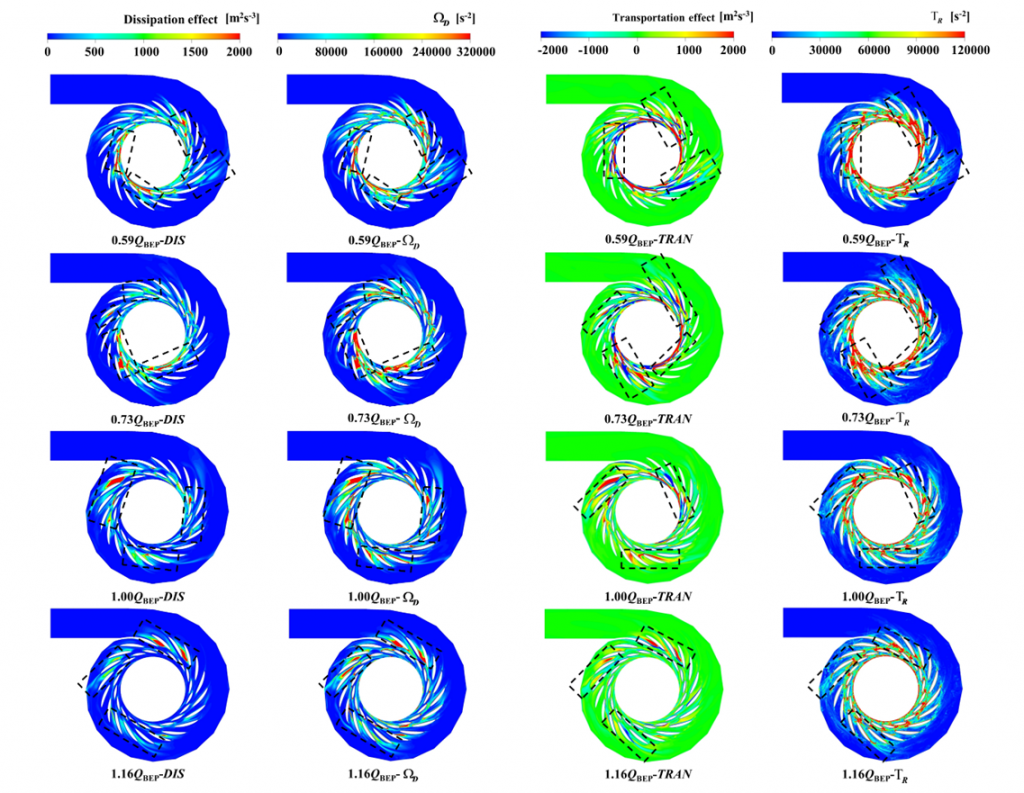 图2 水泵水轮机泵工况关键流域局部水力损失分布与旋涡演化特性分布对比
图2 水泵水轮机泵工况关键流域局部水力损失分布与旋涡演化特性分布对比
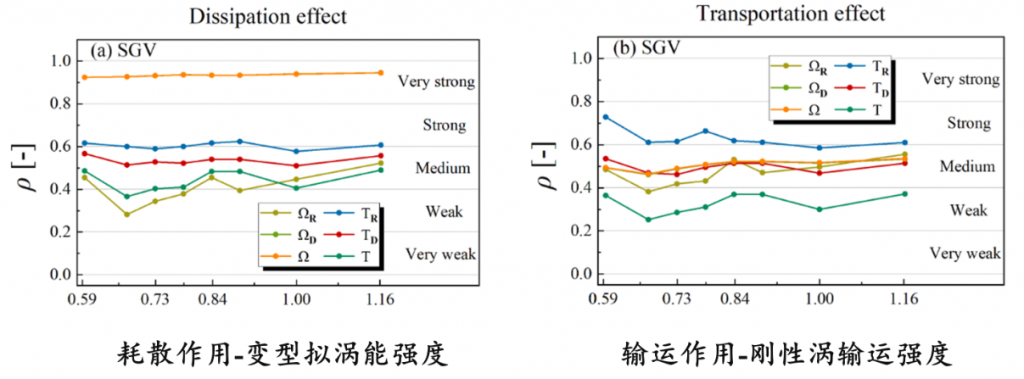 图3 水泵水轮机泵工况关键流域内水力损失与旋涡演化相关性分析
图3 水泵水轮机泵工况关键流域内水力损失与旋涡演化相关性分析
第一作者简介:

覃永粼,哈尔滨工业大学博士三年级在读研究生,本、硕均毕业于哈尔滨工业大学,曾于本科期间获得国家奖学金。研究方向包括水泵水轮机多目标水力特性优化研究、水力损失机理研究、水力损失与旋涡演化相关性研究等等;目前,其所提出的转轮高压边三维优化策略已被应用于某抽水蓄能机组中,并在Renewable Energy、Journal of Energy Storage、Sustainable Energy Technologies and Assessments等杂志上发表学术论文10篇,其中一作SCI论文4篇,并参加国际IAHR会议及国内抽水蓄能专业委员会学术交流年会。
通讯作者简介:
 李德友,工学博士,青年拔尖教授,博士生导师,能源学院院长专项助理,流体机械及工程研究所副所长,担任中国电机工程学会风力与潮汐发电专业委员会委员、中国水力发电工程学会抽水蓄能专委会委员、SAC/TC175/WG2“水力机械振动”标准工作组成员、SCI期刊Journal of Hydrodynamics编委、中国水力发电工程学会抽水蓄能专委会委员、《排灌机械工程学报》青年编委、IAHR会员等20余项职务,围绕双碳目标,面向国家专项,从事抽水蓄能机组及航空航天特种流体机械流动机理及流动控制策略研究,先后获2021年中国动力工程学会青年科技奖、2020年黑龙江省自然科学一等奖(排名2)、中国产学研合作创新与促进奖二等奖(排名3);入选2021年秋哈工大青年拔尖人才选聘计划-拔尖教授、2020年黑龙江省博士后青年英才计划、2018年秋哈工大青年拔尖人才选聘计划-拔尖副教授,主持国家自然科学基金面上项目、青年项目、中国博士后科学基金特别资助、十三五装备预研领域基金子课题等30余项;在Renewable & Sustainable Energy Reviews、Energy Conversion and Management、Journal of Cleaner Production、Renewable Energy、Physics of Fluids、AIAA Journal、Journal of Hydraulic Research、ASME Journal of Fluids Engineering等杂志上发表学术论文75篇,其中一作SCI论文35篇,通讯12篇(ESI高被引论文3篇,Top期刊19篇),授权/受理专利15项,软件著作10项。担任国家精品资源共享课、国家精品课程《工程流体力学》主讲教师,负责和参与教学项目10余项,发表教学论文10篇。指导学生获全国能源动力类优秀本科毕业设计论文、全国大学生节能减排竞赛一等奖等40余项奖励和荣誉。担任国家自然科学基金、教育部学位论文通讯评审专家。
李德友,工学博士,青年拔尖教授,博士生导师,能源学院院长专项助理,流体机械及工程研究所副所长,担任中国电机工程学会风力与潮汐发电专业委员会委员、中国水力发电工程学会抽水蓄能专委会委员、SAC/TC175/WG2“水力机械振动”标准工作组成员、SCI期刊Journal of Hydrodynamics编委、中国水力发电工程学会抽水蓄能专委会委员、《排灌机械工程学报》青年编委、IAHR会员等20余项职务,围绕双碳目标,面向国家专项,从事抽水蓄能机组及航空航天特种流体机械流动机理及流动控制策略研究,先后获2021年中国动力工程学会青年科技奖、2020年黑龙江省自然科学一等奖(排名2)、中国产学研合作创新与促进奖二等奖(排名3);入选2021年秋哈工大青年拔尖人才选聘计划-拔尖教授、2020年黑龙江省博士后青年英才计划、2018年秋哈工大青年拔尖人才选聘计划-拔尖副教授,主持国家自然科学基金面上项目、青年项目、中国博士后科学基金特别资助、十三五装备预研领域基金子课题等30余项;在Renewable & Sustainable Energy Reviews、Energy Conversion and Management、Journal of Cleaner Production、Renewable Energy、Physics of Fluids、AIAA Journal、Journal of Hydraulic Research、ASME Journal of Fluids Engineering等杂志上发表学术论文75篇,其中一作SCI论文35篇,通讯12篇(ESI高被引论文3篇,Top期刊19篇),授权/受理专利15项,软件著作10项。担任国家精品资源共享课、国家精品课程《工程流体力学》主讲教师,负责和参与教学项目10余项,发表教学论文10篇。指导学生获全国能源动力类优秀本科毕业设计论文、全国大学生节能减排竞赛一等奖等40余项奖励和荣誉。担任国家自然科学基金、教育部学位论文通讯评审专家。
